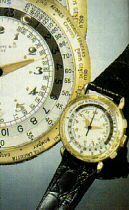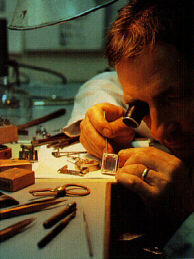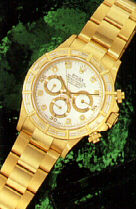
 |
After quartz technology through the watch industry in the '70s, nearly
 The world- record breaking 1940 Patek Philippe wristwatch, auctioned off one year ago by antiquorum for $790,000 The world- record breaking 1940 Patek Philippe wristwatch, auctioned off one year ago by antiquorum for $790,000 |
It began in the '70s when a few prescient entrepreneurs noticed a new phenomenon: The public was beginning to be interested in vintage wristwatches. These dealers started paying some very nice prices for old watches that a year or two before would have had value only as scrap; then they resold them for even nicer prices.
The trend ballooned and by the early '80s the major auction houses were holding sales devoted exclusively to vintage wristwatches. Prices rocketed, especially for pieces made by the top echelon of Swiss manufacturers. Complicated pieces, including chronographs, perpetual calendars, minute repeaters and the like, brought the highest prices of all.
Several factors drove the boom. First, as quartz became ever more common, people saw that mechanical watches were threatened with extinction. Every year they became rarer and hence more valuable. The triumph of quartz spurred demand for vintage mechanicals the same way the triumph of the wristwatch had many years before created a collectibles market for old pocket watches.
 |
 Top: A watchmaker at work on a Jaeger- LeCoultre Reverso watch Top: A watchmaker at work on a Jaeger- LeCoultre Reverso watchLeft: A Rolex Mechanical Oyster Perpetual |
Another factor: A vintage wristwatch was the ideal accessory for the proud ad executive or arbitrageur who was making it big in the fast-track'80s. A fine old wristwatch with a big Swiss name proved you were not just rich but also gifted with a certain amount of savoir faire.
Then, of course, there was the vast amount of money being made during the '80s not just in the U.S. but in Asia and Europe. Collectors and speculators all over the world poured their millions into watches just as they did into impressionist paintings.
It was just a matter of time before watch companies realized there would be eager customers for new mechanical wristwatches as well as old. In the late '80s Swiss companies started to bring forth bevies of luxury mechanical watches, a trend that has been gaining force every year since. Some are skeleton models that display their charmingly old-fashioned innards through a transparent dial or case back. Complicated watches, especially chronographs, are flourishing. So are automatic, or self-winding watches.
Companies like Rolex and Patek Philippe, which have stayed true to the mechanical throughout the quartz era, today enjoy record sales. Mechanical models now have unprecedented prestige. Why else would the Swiss company Blancpain boast: "Since 1735 there has never been a quartz Blancpain watch. And there never will be"?
The mechanical revival has been a windfall for the Swiss industry. Between 1988 and 1990 Swiss production of mechanical watches grew 70%. Last year, half of the country's watch revenue came from mechanical models, although only 13% of the watches it produced were mechanicals.
In the meantime, the auction market, except for
one major decline just before and during the recession of the early '90s, has
continued to soar, further fueling the mechanical boom. Just last October a
world record was set in Geneva for the highest dollar amount ever paid for a
wristwatch at auction. It was a Patek Philippe world timer gaveled off by Antiquorum,
and it brought an eye-popping $790,000. (Valued in Swiss francs the watch was
second to a platinum Patek sold some years earlier.) And in June of this year,
Patek Philippe bought one of its own watches at Sotheby's in New York for $519,500,
setting a record for a Patek sold at auction in this country.